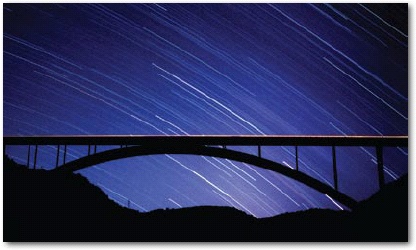The Star-Trails Shot
You've probably seen this amazing astronomy shot, where the stars in the night sky seem to swirl around in concentric circles.

As you can probably guess, the swirling comes from the rotation of the earth relative to the stars. And it takes a long time to swirl that much; hours, in fact.
As a result, the star-trails shot is the exclusive domain of SLRs. (Pocket cameras don't offer a shutter speed that's slow enough.) So here's the drill:
Use a tripod. (You were thinking handheld? Are you kidding?)
Compose the shot. Very important: Include more than just the sky! Including some land, preferably something interesting in the foreground, gives the star trails a sense of scale and orientation. And the juxtaposition of elementsâthe streaking blurs in the sky, the super-sharp, steady ground featuresâmakes the picture much more striking.
Use a cable release (Cable Shutter Release), remote control, or the self-timer.
Start with a full battery charge! Or run your camera plugged in, if it permits that arrangement.
Moonless nights work best. Your shutter will be open for a long time, soaking in light. And too much lightâfrom a full moon, for exampleâcan overexpose the photo (make it too bright). Oh, and by the way: Cloudless nights are a good idea, too.
Sometimes the cool night air makes your lens fog up. A skier's hand warmer wrapped around the lens might help, or socks held ...
Get David Pogue's Digital Photography: The Missing Manual now with the O’Reilly learning platform.
O’Reilly members experience books, live events, courses curated by job role, and more from O’Reilly and nearly 200 top publishers.

